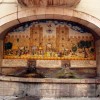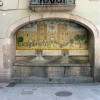Source Portaferrissa
Carrer de la Portaferrissa
Unattributed
Ceramics: John the Baptist Guivernau signed
Text: Peter Returns
Materials: Montjuïc stone with ceramic tiled
Opening: October 24, 1959
On 15 May 1680, the director of the school of Bethlehem, the Jesuits (in the present corner of the Rambla and Carrer del Carme), addressed to the Council asking for permission to move Cent elsewhere a public fountain that was built in 1604 next to the school and that "it was very pregnant," because in that place there wanted to build a chapel to replace what had burned 1671. the Jesuits would take over the costs of the transfer to the place that you wish. Directors indicated that you could put it attached to one of the towers of the post Ferriss, the walls of Rambla, specifically in the tower next to the sea, the closest to the Boqueria. This was done, and power passed from one side to the other of the Rambla. The construction of the Bethlehem Church thus continued without "pregnancy", following plans by Josep Juli 1690 and was finished in front of Carmen Street, although it took forty years to complete the structure temple and more than a century to finish the interior.
As to the source, twenty years after it was moved began to rise before him, across the street from Gate Ferriss and even within the walls of the palace of Peter Cartellà demolished 1771 and replaced by a new one that took the name of Palau Moja, which is still preserved. It was precisely because of the construction of this palace that towers were demolished Gate Ferriss -the wall was slowly disappearing throughout the eighteenth and nineteenth centuries, but the power remained in place. On 24 September 1959 we started decorating ceramic panels, by John the Baptist Guivernau. Door explanatory text that was written by Peter returns. The initiative came from the association of shopkeepers street Portaferrissa, and Cucurulla Boters.
-
Gòtic - C. de la Portaferrissa, 2
-
Metro
L3 LICEU







